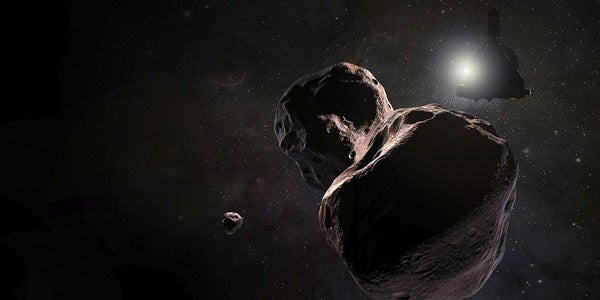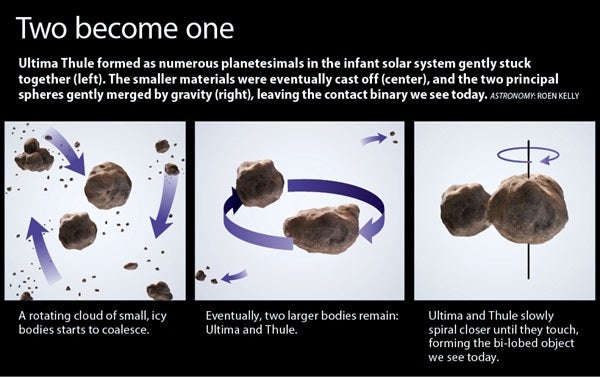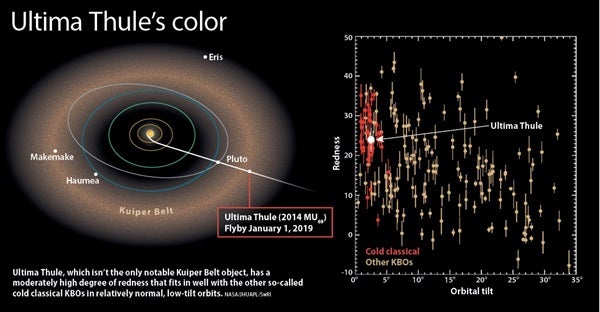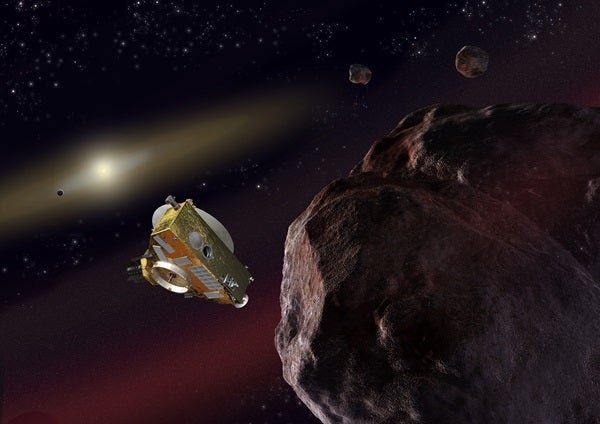It could not have been set up any better. And its master architect, planetary scientist Alan Stern, had that in mind all along. On New Year’s Eve and New Year’s Day 2019, the famed New Horizons spacecraft had a date. In 2015, this intrepid explorer swung past the dwarf planet Pluto, giving us our first close-up view of that world and its system of moons. Now, New Horizons would take on a second target much farther out than Pluto, a distant Kuiper Belt object (KBO).
The New Horizons science team named this strange object Ultima Thule (pronounced TOO-lee), Latin for “beyond the known world.
The flyby of Ultima Thule would mark a hugely significant event: the most distant human exploration of a body in world history. And the timing, coinciding with New Year’s Eve parties from Times Square and elsewhere, would capitalize on amazing publicity that would catapult planetary exploration into hundreds of millions of living rooms across the globe. The whole extravaganza was marked by several hundred scientists and journalists converging on the campus of the Johns Hopkins Applied Physics Laboratory in Baltimore, the mission’s headquarters.
I was invited to this unique New Year’s party by the lead architect and party master, Stern himself. He serves as the mission’s principal investigator, and he will contribute a story in an upcoming issue of Astronomy that will summarize the depth of the scientific findings about Ultima Thule. For now, my mission was to soak in the historic moment and to highlight the first results, the first images. Accompanying me was Senior Editor Rich Talcott, who was also busy with coverage. And the party would have a unique contribution from a friend: Brian May, a New Horizons team member and guitarist of the legendary band Queen, was on hand to debut his new song, dedicated to New Horizons.
The planning for this first-ever encounter with a KBO extended back to days after the Pluto flyby in 2015. With New Horizons showing us that dynamic little world, with its light-colored, heart-shaped Tombaugh Regio, we were all stunned by the close-up imagery of what had been the last unexplored major body of the solar system. (Yes, Pluto was demoted to dwarf planet status in 2006, but the plans had long been underway to visit this world, viewed as being on the virtual edge of our solar system.)
Drawing a bead on the Kuiper Belt
Between Pluto’s discovery in 1930 and the spacecraft’s arrival in 2015, our knowledge of the framework of the solar system changed, regardless of whether you think of Pluto as a planet or something less. In 1992, astronomers David Jewitt and Jane Luu discovered the first KBO — 1992 QB1, nicknamed Albion — and we now know that a vast population of icy bodies exists beyond the orbit of Neptune, of which Pluto appears to be the largest.
We’d also since learned about three distinct populations of bodies in the solar system: the terrestrial planets, the gas and ice giants, and the Kuiper Belt. The latter probably holds tens or hundreds of thousands of small, icy bodies beyond Neptune. That’s roughly 40 astronomical units (AU) away from the Sun, or 40 times the Sun-Earth distance — a long way out. And yet the outer edge of the Oort Cloud, comprising some 2 trillion cometary nuclei, stretches some 50,000 AU away from the Sun. Exploration by spacecraft of the outermost reaches of the solar system still has a long way to go.
What makes exploring the Kuiper Belt particularly exciting for planetary scientists is plain old chemistry. Bodies in the inner solar system — be they planets, moons, asteroids, or infalling comets — are all subject to major chemical changes as they evolve because the Sun warms them and makes those reactions possible. The Kuiper Belt, however, is in a deep freeze. The temperatures of the icy bodies there — many of which have been there since they formed, planetary scientists believe — make ordinary chemical reactions impossible. So these objects, including Ultima Thule, offer a way for scientists to look back in time to the pristine conditions of the early solar system. Maybe we can even better understand its very formation.
The Kuiper Belt stretches from about 30 AU to its outer edge at some 55 AU from the Sun. Sometimes it is called the Edgeworth-Kuiper Belt, as the great Dutch-American astronomer Gerard Kuiper hypothesized it, and the independent Irish astronomer Kenneth Edgeworth helped to confirm it. The name is a bit of a misnomer: The Kuiper Belt is more of a doughnut, or torus, than a belt. It is somewhat thick, with many objects extending 10° outside its plane, and it is inclined relative to the ecliptic, the plane made by Earth’s orbit around the Sun, by about 2°.
KBOs, perhaps vast in number, are leftover debris and icy chunks from the solar system’s early days. Their heritage is made more complicated by the existence of Neptune, whose presence throws the orbits of many of the objects out of whack, making them unstable. Within a zone of about 42 to 48 AU from the Sun, most of the objects can remain stable for a long time. The planet does establish resonances, at 2:3, or 1:2. That is, an object in 2:3 resonance with Neptune completes two orbits around the Sun for every three Neptunian orbits. An object in 1:2 resonance completes an orbit once every two Neptunian orbits. Objects in these resonances can remain stable, without Neptune kicking them outward into unstable orbits.
Pluto: The dominant KBO
The first known KBO was not actually 1992 QB1, but Pluto. Discovered in 1930 and labeled a planet, Pluto was the result of the long search at Lowell Observatory for an outer planet. Believed to be both more massive and more distant than Pluto turned out to be, the hypothetical planet ultimately didn’t exist — but the search did uncover Pluto.
By the 1990s, it was becoming clear that a large population of icy objects existed in the realm beyond Neptune. Scientists call these bodies trans-Neptunian objects (TNOs), and many of them, they came to find out, exist in the Kuiper Belt.
Beyond the Kuiper Belt lies another, sparser population of icy asteroid-like bodies, in the so-called Scattered Disk. These objects have been disrupted by Neptune or other bodies, and they have high inclinations and eccentricities — weird orbits that have them careening up and down at odd angles relative to the plane of the major solar system planets.
Within the last generation, whether or not you consider it a planet, Pluto has come to be recognized as the largest KBO. With a diameter of 1,477 miles (2,370 kilometers), Pluto is the largest body in the Kuiper Belt, and it has five satellites, one of which, Charon, is quite large. But it’s not the only significant KBO known. Dwarf planet Haumea spans 1,000 miles (1,600 km), dwarf planet Makemake measures 890 miles (1,430 km) across, and 50000 Quaoar is more than 750 miles (1,200 km) across.
The Kuiper Belt also has several populations. The main one, the so-called classical population, holds about two-thirds of the objects. It contains both cold and hot objects, referring not to temperatures — they’re all cold — but to orbits. The cold classicals have nearly circular orbits with small eccentricities. The hot population is characterized by much more inclined orbits.
Resonances also play a role in defining the objects. The 2:3 resonant group consists of at least 200 objects, including Pluto. This gives the group the nickname “Plutinos.” The 1:2 resonant group is more sparsely populated and is nicknamed “twotinos.”
Partying with Ultima Thule
We arrived in Baltimore to celebrate a suddenly famous member of the cold classical Kuiper Belt family, Ultima Thule. Originally designated 2014 MU69, the object being approached by New Horizons remained mysterious until the final days and hours of the encounter. Near year’s end, the New Horizons team believed Ultima Thule to be about 20 miles (30 km) across and quite elongated. Months earlier, Earth-based observations of Ultima Thule occulting (passing in front of) stars led the team to suspect a binary shape.
The prediction turned out to be right: On the first data release, we got an image of an object that resembled a bowling pin, but with few pixels to support the certainty. The next day, when the highest-resolution images were released in early January, the object clearly appeared to be a binary, giving rise to the name “Cosmic Snowman.” In fact, the team determined Ultima Thule to be a contact binary, two objects that gravitationally migrated inward and stuck together. Thus, we had the first close-up observations of a contact binary in history. The team, in a tribute to simplicity, named the larger sphere Ultima and the smaller one Thule.
The atmosphere in the press auditorium at Johns Hopkins was electric, as it has been for many other key moments in space exploration. Perhaps 200 people or so — media, scientists, family, and friends — packed the room, and at important announcements of success, applause and sometimes screams of joy erupted. Many press conferences and talks entertained the attendees, and Stern took center stage much of the time, communicating the latest news and explaining a vast amount of knowledge for the media. Others featured prominently, too — and far too many to mention — but they included major mission participants like Cathy Olkin, John Spencer, Hal Weaver, Joel Parker, Alice Bowman, Frederic Pelletier, Marc Buie, Will Grundy, Jeff Moore, Leslie Young, Kelsi Singer, Kirby Runyon, Bill McKinnon, Alex Parker, and Andy Cheng.
When it came time for the New Year’s Eve celebration itself, we moved to a large, open area with a beautiful stage. Champagne in hand, we counted down to the closest approach of the spacecraft to Ultima Thule, knowing that history was about to be made, although we wouldn’t have the imagery and other data in hand until the next morning. (The telemetry time from the Kuiper Belt back to Earth was about six hours.)
To celebrate, May took to the stage and introduced the video he created, his first solo release song in two decades, “New Horizons (Ultima Thule Mix).” The crowd, stunned and amazed, loved it, and we had one tremendous party going. Then Stern mounted the stage and, accompanied by a large group of schoolkids, celebrated the spirit of discovery at this critical time.
And then we crashed, getting up early for exciting and important press conferences — and those magical pictures of the Cosmic Snowman. The early data releases tell the tale of an alien world — the most distant object ever visited by human technology. We will see this story repeated, even likely by this spacecraft, as it ventures deeper into the abyss.













